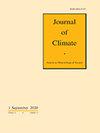Influence of Natural External Forcings on Interdecadal Variation of Global Land Monsoon over the last millennium in CESM-LME
IF 4
2区 地球科学
Q1 METEOROLOGY & ATMOSPHERIC SCIENCES
引用次数: 0
Abstract
Abstract Interdecadal variations of the global land monsoon have been previously attributed to internal fluctuations of the climate system, but the role of natural external forcings was under-explored. Here, we investigate this issue by using the Community Earth System Model ensemble simulations over the last millennium (950-1850 A.D.). Our analysis reveals that the surface temperature, with two dominant structures (global cooling/warming and longitudinal sea-surface temperature gradient in the tropical Pacific, which affects the Walker circulation), predominantly shapes the leading forced mode of the global land monsoon. This mode, representing 19% of the total variance, manifests as consistent features across South Asia, the southern part of East Asia, North Australia, South America, and western South Africa, contrasting with other monsoon regions. Under global cooling conditions, the monsoon intensity is enhanced in the northern parts of the East Asian and eastern parts of the North and South African monsoons, but it decreases in the other monsoon regions. Under weak Walker circulation conditions, changes in atmospheric circulation in response to the sea surface temperature gradient in the tropical Pacific are associated with a substantial attenuation of almost all land monsoon regions. It was further shown that the global mean surface temperature and the tropical Pacific temperature gradient jointly account for 75% of the total variance in the leading mode of the global land monsoon, with 29% and 46% as their respective contribution. Furthermore, our results suggest that volcanic eruptions are the dominant external forcing for these variations. These findings provide valuable insights for future research on global monsoon dynamics.过去千年 CESM-LME 中外部自然因素对全球陆地季风年代际变化的影响
摘要 全球陆地季风的年代际变化以前一直被归因于气候系统的内部波动,但对自然外力作用的探讨不足。在此,我们利用共同体地球系统模式对过去一千年(公元 950-1850 年)的集合模拟来研究这一问题。我们的分析表明,具有两种主导结构(全球变冷/变暖和影响沃克环流的热带太平洋纵向海面温度梯度)的地表温度主要塑造了全球陆地季风的主导强迫模式。这种模式占总变异的 19%,在南亚、东亚南部、北澳大利亚、南美洲和南非西部表现为一致的特征,与其他季风区形成鲜明对比。在全球变冷条件下,东亚季风区北部、北非和南非季风区东部的季风强度增强,但其他季风区的季风强度减弱。在弱沃克环流条件下,大气环流对热带太平洋海面温度梯度的响应变化与几乎所有陆地季风区的大幅衰减有关。研究进一步表明,全球平均表面温度和热带太平洋温度梯度共同占全球陆地季风主导模式总方差的 75%,它们各自的贡献率分别为 29%和 46%。此外,我们的研究结果表明,火山爆发是这些变化的主要外部影响因素。这些发现为未来全球季风动力学研究提供了宝贵的启示。
本文章由计算机程序翻译,如有差异,请以英文原文为准。
求助全文
约1分钟内获得全文
求助全文
来源期刊

Journal of Climate
地学-气象与大气科学
CiteScore
9.30
自引率
14.30%
发文量
490
审稿时长
7.5 months
期刊介绍:
The Journal of Climate (JCLI) (ISSN: 0894-8755; eISSN: 1520-0442) publishes research that advances basic understanding of the dynamics and physics of the climate system on large spatial scales, including variability of the atmosphere, oceans, land surface, and cryosphere; past, present, and projected future changes in the climate system; and climate simulation and prediction.
 求助内容:
求助内容: 应助结果提醒方式:
应助结果提醒方式:


